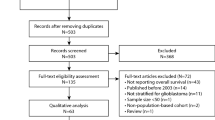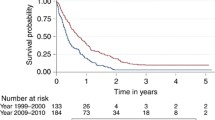Abstract
The EORTC/NCIC 22981/26981 study demonstrated an improvement in median overall survival (OS) from 12.1 to 14.6 months in patients with glioblastoma (GBM) who received temozolomide with post-operative radiotherapy (RT). The current study was performed to determine if those results translated into a survival benefit in a population-based cohort. Patients diagnosed between 2000 and 2006 with a GBM who underwent surgery and post-operative RT were selected from the Surveillance, Epidemiology and End Results database. Patients were grouped into time periods: 2000–2001, 2002–2003, 2004 and 2005–2006 (which represented those treated after the EORTC/NCIC trial presentation in 2004). Relative survival (RS) was estimated by the Kaplan–Meier method, and Cox multivariable regression modeling was used to estimate proportional hazard ratios (HR). Over time, there was improvement in the median and 2-year RS of 12 months and 15% for 2000–2001, 13 months and 19% for 2002–2003, 14 months and 24% for 2004, and 15 months and 26% for 2005–2006 (P < 0.0001 compared to 2000–2001 and 2002–2003; P = 0.07 compared to 2004). The estimated adjusted HR showed that patients diagnosed in 2005–2006 had significantly improved survival when compared to patients diagnosed in 2000–2001 (HR = 0.648, 95% CI 0.604–0.696). The median and 2 year RS of 15 months and 26% in 2005–2006 was similar to the median and 2 year OS of 14.6 months and 26% seen in the EORTC/NCIC phase III study. These results are encouraging and suggest that the current treatment of glioblastoma nationwide is now associated with an improved survival compared to previous time cohorts.


Similar content being viewed by others
References
Tran B, Rosenthal MA (2010) Survival comparison between glioblastoma multiforme and other incurable cancers. J Clin Neurosci 17:417–421. doi:10.1016/j.jocn.2009.09.004
Buckner JC (2003) Factors influencing survival in high-grade gliomas. Semin Oncol 30:10–14
Curran WJ Jr, Scott CB, Horton J, Nelson JS, Weinstein AS, Fischbach AJ, Chang CH, Rotman M, Asbell SO, Krisch RE (1993) Recursive partitioning analysis of prognostic factors in three Radiation Therapy Oncology Group malignant glioma trials. J Natl Cancer Inst 85:704–710
DeAngelis LM (2001) Brain tumors. N Engl J Med 344:114–123. doi:10.1056/NEJM200101113440207
CBTRUS (2010) CBTRUS statistical report: primary brain and central nervous system tumors diagnosed in the United States in 2004–2007
Laperriere N, Zuraw L, Cairncross G, Cancer Care Ontario Practice Guidelines Initiative Neuro-Oncology Disease Site Group (2002) Radiotherapy for newly diagnosed malignant glioma in adults: a systematic review. Radiother Oncol 64:259–273
Stupp R, Mason WP, van den Bent MJ, Weller M, Fisher B, Taphoorn MJ, Belanger K, Brandes AA, Marosi C, Bogdahn U et al (2005) Radiotherapy plus concomitant and adjuvant temozolomide for glioblastoma. N Engl J Med 352:987–996. doi:10.1056/NEJMoa043330
Stupp R, van den Bent MJ, Hegi ME (2005) Optimal role of temozolomide in the treatment of malignant gliomas. Curr Neurol Neurosci Rep 5:198–206
Stupp R, Hegi ME, Mason WP, van den Bent MJ, Taphoorn MJ, Janzer RC, Ludwin SK, Allgeier A, Fisher B, Belanger K et al (2009) Effects of radiotherapy with concomitant and adjuvant temozolomide versus radiotherapy alone on survival in glioblastoma in a randomised phase III study: 5-year analysis of the EORTC-NCIC trial. Lancet Oncol 10:459–466. doi:10.1016/S1470-2045(09)70025-7
Linz U (2010) Commentary on effects of radiotherapy with concomitant, adjuvant temozolomide versus radiotherapy alone on survival in glioblastoma in a randomised phase III study: 5-year analysis of the EORTC-NCIC trial (Lancet Oncol.2009;10:459–466). Cancer 116:1844–1846. doi:10.1002/cncr.24950
National Cancer Institute, DCCPS, Surveillance Research Program, Cancer Statistics Branch (Released April 2010, based on the November 2009 submission) Surveillance, Epidemiology, and End Results (SEER) Program (www.seer.cancer.gov) SEER*Stat Database: Incidence—SEER 17 Regs Research Data + Hurricane Katrina Impacted Louisiana Cases, Nov 2009 Sub (1973–2007 varying)—Linked To County Attributes—Total U.S., 1969–2009 Counties
Hosmer DW, Lemeshow S, May S (2008) Applied survival analysis: regression modeling of time-to-event data. Wiley-Interscience, Hoboken
Surveillance Research Program, National Cancer Institute SEER*Stat software (seer.cancer.gov/seerstat). Version 7.0.4
Westphal M, Hilt DC, Bortey E, Delavault P, Olivares R, Warnke PC, Whittle IR, Jaaskelainen J, Ram Z (2003) A phase 3 trial of local chemotherapy with biodegradable carmustine (BCNU) wafers (Gliadel wafers) in patients with primary malignant glioma. Neuro Oncol 5:79–88. doi:10.1215/S1522-8517-02-00023-6
Stark-Vance V (2005) Bevacizumab and CPT-11 in the treatment of relapsed malignant glioma (Abstract). Neuro-oncology 7:369
Meyer FB, Bates LM, Goerss SJ, Friedman JA, Windschitl WL, Duffy JR, Perkins WJ, O’Neill BP (2001) Awake craniotomy for aggressive resection of primary gliomas located in eloquent brain. Mayo Clin Proc 76:677–687
Sanai N, Mirzadeh Z, Berger MS (2008) Functional outcome after language mapping for glioma resection. N Engl J Med 358:18–27. doi:10.1056/NEJMoa067819
Cardinale R, Won M, Choucair A, Gillin M, Chakravarti A, Schultz C, Souhami L, Chen A, Pham H, Mehta M (2006) A phase II trial of accelerated radiotherapy using weekly stereotactic conformal boost for supratentorial glioblastoma multiforme: RTOG 0023. Int J Radiat Oncol Biol Phys 65:1422–1428. doi:10.1016/j.ijrobp.2006.02.042
Larson DA, Suplica JM, Chang SM, Lamborn KR, McDermott MW, Sneed PK, Prados MD, Wara WM, Nicholas MK, Berger MS (2004) Permanent iodine 125 brachytherapy in patients with progressive or recurrent glioblastoma multiforme. Neuro Oncol 6:119–126
Narayana A, Yamada J, Berry S, Shah P, Hunt M, Gutin PH, Leibel SA (2006) Intensity-modulated radiotherapy in high-grade gliomas: clinical and dosimetric results. Int J Radiat Oncol Biol Phys 64:892–897. doi:10.1016/j.ijrobp.2005.05.067
Prisco FE, Weltman E, de Hanriot RM, Brandt RA (2002) Radiosurgical boost for primary high-grade gliomas. J Neurooncol 57:151–160
Simon JM, Cornu P, Boisserie G, Hasboun D, Tep B, Hardiman C, Valery CA, Delattre JY, Dormont D, Baillet F et al (2002) Brachytherapy of glioblastoma recurring in previously irradiated territory: predictive value of tumor volume. Int J Radiat Oncol Biol Phys 53:67–74
Lacroix M, Abi-Said D, Fourney DR, Gokaslan ZL, Shi W, DeMonte F, Lang FF, McCutcheon IE, Hassenbusch SJ, Holland E et al (2001) A multivariate analysis of 416 patients with glioblastoma multiforme: prognosis, extent of resection, and survival. J Neurosurg 95:190–198. doi:10.3171/jns.2001.95.2.0190
Albert FK, Forsting M, Sartor K, Adams HP, Kunze S (1994) Early postoperative magnetic resonance imaging after resection of malignant glioma: objective evaluation of residual tumor and its influence on regrowth and prognosis. Neurosurgery 34:45–60; discussion 60-1
Albert FK, Forsting M (2003) Resection and prognosis. J Neurosurg 98:225–226; author reply 226
Gorlia T, van den Bent MJ, Hegi ME, Mirimanoff RO, Weller M, Cairncross JG, Eisenhauer E, Belanger K, Brandes AA, Allgeier A et al (2008) Nomograms for predicting survival of patients with newly diagnosed glioblastoma: prognostic factor analysis of EORTC and NCIC trial 26981-22981/CE.3. Lancet Oncol 9:29–38. doi:10.1016/S1470-2045(07)70384-4
Curran WJ Jr, Scott CB, Horton J, Nelson JS, Weinstein AS, Fischbach AJ, Chang CH, Rotman M, Asbell SO, Krisch RE (1993) Recursive partitioning analysis of prognostic factors in three Radiation Therapy Oncology Group malignant glioma trials. J Natl Cancer Inst 85:704–710
Scott CB, Scarantino C, Urtasun R, Movsas B, Jones CU, Simpson JR, Fischbach AJ, Curran WJ Jr (1998) Validation and predictive power of Radiation Therapy Oncology Group (RTOG) recursive partitioning analysis classes for malignant glioma patients: a report using RTOG 90-06. Int J Radiat Oncol Biol Phys 40:51–55
Jeremic B, Milicic B, Grujicic D, Dagovic A, Aleksandrovic J (2003) Multivariate analysis of clinical prognostic factors in patients with glioblastoma multiforme treated with a combined modality approach. J Cancer Res Clin Oncol 129:477–484. doi:10.1007/s00432-003-0471-5
Lutterbach J, Sauerbrei W, Guttenberger R (2003) Multivariate analysis of prognostic factors in patients with glioblastoma. Strahlenther Onkol 179:8–15. doi:10.1007/s00066-003-1004-5
Lamborn KR, Chang SM, Prados MD (2004) Prognostic factors for survival of patients with glioblastoma: recursive partitioning analysis. Neuro Oncol 6:227–235. doi:10.1215/S1152851703000620
Yu JB, Gross CP, Wilson LD, Smith BD (2009) NCI SEER public-use data: applications and limitations in oncology research. Oncology 23
Grossman SA, Ye X, Piantadosi S, Desideri S, Nabors LB, Rosenfeld M, Fisher J, Consortium NABTTCNS (2010) Survival of patients with newly diagnosed glioblastoma treated with radiation and temozolomide in research studies in the United States. Clin Cancer Res 16:2443–2449. doi:10.1158/1078-0432.CCR-09-3106
Acknowledgments
This work was presented at the Annual American Society of Clinical Oncology Meeting June 3rd, 2011.
Funding for Therese Dolecek and Bridget McCarthy was supported by the Central Brain Tumor Registry of the United States (CBTRUS) that receives support from the American Brain Tumor Association, the National Brain Tumor Society, the Pediatric Brain Tumor Foundation and from the Division of Cancer Control and Population Sciences, National Cancer Institute, National Institutes of Health, Department of Health and Human Services, under contract # HHSN261201000576P.
Conflict of interest
No author indicated a conflict of interest.
Author information
Authors and Affiliations
Corresponding author
Rights and permissions
About this article
Cite this article
Koshy, M., Villano, J.L., Dolecek, T.A. et al. Improved survival time trends for glioblastoma using the SEER 17 population-based registries. J Neurooncol 107, 207–212 (2012). https://doi.org/10.1007/s11060-011-0738-7
Received:
Accepted:
Published:
Issue Date:
DOI: https://doi.org/10.1007/s11060-011-0738-7




